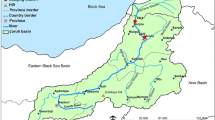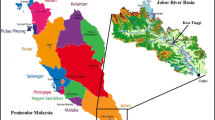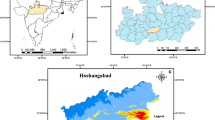Abstract
It is well known that sufficiently long and continuous streamflow data are required for accurate estimations and informed decisions in water-resources planning, design, and management. Although streamflow data are measured and available at most river basins, streamflow records often suffer from insufficient length or missing data. In this work, artificial neural networks (ANNs) are applied to extend daily streamflow records at Lilin station located in Gaoping River basin, southern Taiwan. Two ANNs, including feed forward back propagation (FFBP) and radial basis function (RBF) networks, associated with various time-lagged streamflow and rainfall inputs of nearby long-record stations are employed to extend short daily streamflow records. Performances of ANNs are evaluated by root-mean-square error (RMSE), coefficient of efficiency (CE), and histogram-matching dissimilarity (HMD). Inconsistency among these evaluation measures is solved by the technique for order performance by similarity to ideal solution (TOPSIS), a widely used multi-criteria decision-making approach, to find an optimal model. The results indicate that RBF-E1 (entire-year data training with Q t and Q t−1 inputs) has the minimum RMSE of 104.4 m3/s, second highest CE of 0.956, and third lowest HMD of 0.0096, which outperforms other ANNs and provide the most accurate reconstruction of daily streamflow records at Lilin station.









Similar content being viewed by others
References
Abudu S, Bawazir AS, King JP (2010) Infilling missing daily evapotranspiration data using neural networks. J Irrig Drain Eng 136(5):317–325
Afan HA, El-Shafie A, Yaseen ZM, Hameed MM, Mohtar WHMM, Hussain A (2015) ANN based sediment prediction model utilizing different input scenarios. Water Resour Manag 29(4):1231–1245
Afshar A, Mariño MA, Saadatpour M, Afshar A (2011) Fuzzy TOPSIS multi-criteria decision analysis applied to Karun reservoir system. Water Resour Manag 25(2):545–563
Alley WM, Burns AW (1983) Mixed-station extension of monthly streamflow records. J Hydraul Eng 109(10):1272–1284
ASCE Task Committee on Application of Artificial Neural Networks in Hydrology (2000) Artificial neural networks in hydrology I: preliminary concepts. J Hydrol Eng 5(2):115–123
Besaw LE, Rizzo DM, Bierman PR, Hackett WR (2010) Advances in ungauged streamflow prediction using artificial neural networks. J Hydrol 386:27–37
Chandramouli V, Deka P (2005) Neural network based decision support model for optimal reservoir operation. Water Resour Manag 19(4):447–464
Chang LC, Shen HY, Wang YF, Huang JY, Lin YT (2010) Clustering-based hybrid inundation model for forecasting flood inundation depths. J Hydrol 385:257–268
Cheng CT, Zhao MY, Chau KW, Wu XY (2008) Using genetic algorithm and TOPSIS for Xinanjiang model calibration with a single procedure. J Hydrol 316:129–140
Coulibaly P, Evora ND (2007) Comparison of neural network methods for infilling missing daily weather records. J Hydrol 341:27–41
Dariane AB, Karami F (2014) Deriving hedging rules of multi-reservoir system by online evolving neural networks. Water Resour Manag 28(11):3651–3665
Dastorani MT, Moghadamnia A, Piri J, Rico-Ramirez M (2010) Application of ANN and ANFIS models for reconstructing missing flow data. Environ Monit Assess 166(1-4):421–434
Dumedah G, Walker JP, Chik L (2014) Assessing artificial neural networks and statistical methods for infilling missing soil moisture records. J Hydrol 515:330–344
Fayaed SS, El-Shafie A, Jaafar O (2013) Integrated artificial neural network (ANN) and stochastic dynamic programming (SDP) model for optimal release policy. Water Resour Manag 27(10):3679–3696
Grygier JC, Stedinger JR, Yin HB (1989) A generalized maintenance of variance extension procedure for extending correlated series. Water Resour Res 25(3):345–349
Hirsch RM (1979) An evaluation of some record reconstruction techniques. Water Resour Res 15(6):1781–1790
Hirsch RM (1982) A comparison of four streamflow record extension techniques. Water Resour Res 18(4):1081–1088
Hwang CL, Yoon K (1981) Multiple attributes decision making methods and applications. Springer, Heidelberg
Kashani MH, Dinpashoh Y (2012) Evaluation of efficiency of different estimation methods for missing climatological data. Stoch Env Res Risk A 26(1):59–71
Khalil B, Adamowski J (2012) Record extension for short-gauged water quality parameters using a newly proposed robust version of the line of organic correlation technique. Hydrol Earth Syst Sci 16(7):2253–2266
Khalil B, Adamowski J (2014) Comparison of OLS, ANN, KTRL, KTRL2, RLOC, and MOVE as record-extension techniques for water quality variables. Water Air Soil Pollut 225(6):1966
Khalil B, Ouarda TBMJ, St-Hilaire A (2012) Comparison of record-extension techniques for water quality variables. Water Resour Manag 26(14):4259–4280
Kim RJ, Loucks DP, Stedinger JR (2012) Artificial neural networks models of watershed nutrient loading. Water Resour Manag 26(10):2781–2797
Lin GF, Chen LH (2005) Time series forecasting by combining the radial basis function network and the self-organizing map. Hydrol Process 19(10):1925–1937
Moog DB, Whiting PJ (1999) Streamflow record extension using power transformations and application to sediment transport. Water Resour Res 35(1):243–254
Mwale FD, Adeloye AJ, Rustum R (2012) Infilling of missing rainfall and streamflow data in the Shire River basin, Malawi—a self organizing map approach. Phys Chem Earth 50–52:34–43
Nevitt J, Tam HP (1998) A comparison of robust and nonparametric estimators under the simple linear regression model. Mult Linear Regression Viewpoints 25(1):54–69
Ng WW, Panu US, Lennox WC (2009) Comparative studies in problems of missing extreme daily streamflow records. J Hydrol Eng 14(1):91–100
Nkuna TR, Odiyo JO (2011) Filling of missing rainfall data in Luvuvhu River catchment using artificial neural network. Phys Chem Earth 36:830–835
Shen HY, Chang LC (2013) Online multistep-ahead inundation depth forecasts by recurrent NARX networks. Hydrol Earth Syst Sci 17(3):935–945
Shiau JT, Wu FC (2008) A histogram matching approach for assessment of flow regime alteration: application to environmental flow optimization. River Res Appl 24(7):914–928
Shiau JT, Wu FC (2010) A dual active-restrictive approach to incorporating environmental flow targets into existing reservoir operation rules. Water Resour Res 46(8):W08515. doi:10.1029/2009WR008765
Shiau JT, Wu FC (2013) Optimizing environmental flows for multiple reaches affected by a multipurpose reservoir system in Taiwan: restoring natural flow regimes at multiple temporal scales. Water Resour Res 49(1):565–584
Singh P, Deo MC (2007) Suitability of different neural networks in daily flow forecasting. Appl Soft Comput 7(3):968–978
Srdjevic B, Medeiros YDP, Faria AS (2004) An objective multi-criteria evaluation of water management scenarios. Water Resour Manag 18(1):35–54
Trichakis IC, Nikolos IK, Karatzas GP (2011) Artificial neural network (ANN) based modeling for karstic groundwater level simulation. Water Resour Manag 25(4):1143–1152
Author information
Authors and Affiliations
Corresponding author
Rights and permissions
About this article
Cite this article
Shiau, JT., Hsu, HT. Suitability of ANN-Based Daily Streamflow Extension Models: a Case Study of Gaoping River Basin, Taiwan. Water Resour Manage 30, 1499–1513 (2016). https://doi.org/10.1007/s11269-016-1235-8
Received:
Accepted:
Published:
Issue Date:
DOI: https://doi.org/10.1007/s11269-016-1235-8




